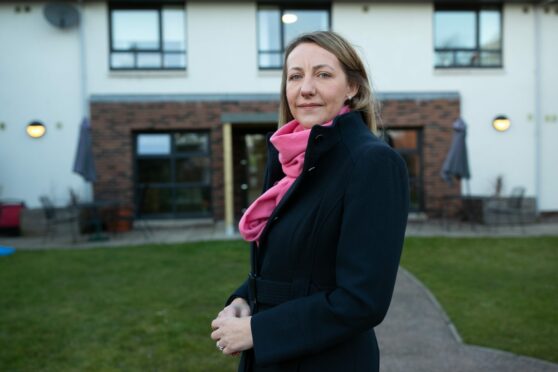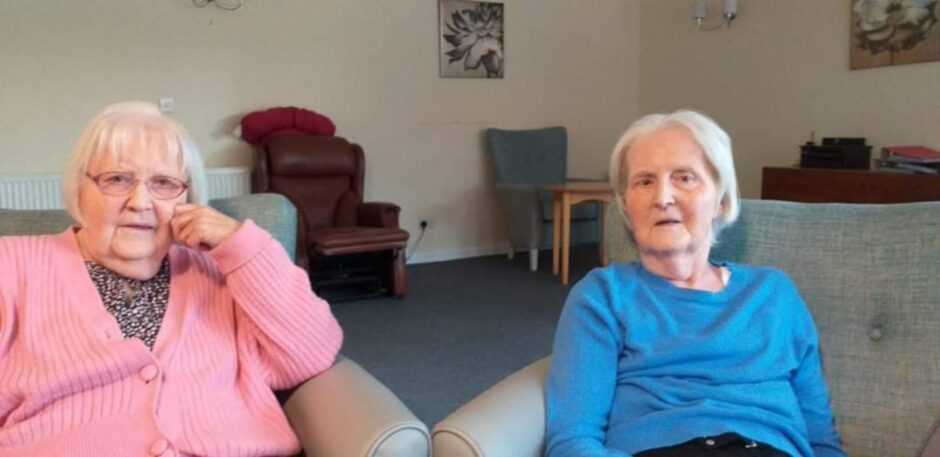
Care homes are closing because they can’t afford to pay rising energy costs and many more will shut in the coming months, making hundreds of elderly and vulnerable people homeless, the sector has warned.
Dr Donald Macaskill, chief executive of umbrella body Scottish Care, said the crisis could bring the NHS to its knees before winter because hospitals will have no choice but to take in evicted residents who have nowhere else to go.
He also warned lives could be lost because the trauma of care home closures has a life-shortening effect on the most vulnerable. The majority of Scotland’s 797 care homes are small businesses, often family-run, and some are facing a six-fold increase in energy costs. One facility in a rural area paid £6,000 for electricity and gas last year but that is rising to £36,000. Another care home will see its annual bill rise from £40,000 to £210,000.
Broomfield Court Care Home in Barmulloch, Glasgow, closed in June, with rising energy bills blamed. Former operators Larchwood said the facility was not financially viable, adding: “This has been exacerbated by the level of fees set which has not taken into account the huge rise in energy costs which has impacted the whole sector.”
Moncreiffe Care Home in Bridge of Earn was closed last month with businessman John Bryden saying eye-watering energy bills were part of a perfect storm of problems which made the facility unsustainable to operate. The building has since been put up for sale. Dr Donald Macaskill of Scottish Care said: “I am now more worried about the survival of social care delivery in Scotland than at any time before or during the Covid pandemic.
“We are living in the midst of a perfect storm and already in the last month high-quality and excellent performing care homes have either closed or intimated their intention to cease delivery.
“The proverbial straw which has led many to intimate to me they will simply not survive until the year’s end is the spiralling cost of energy combined with the wider cost-of-living crisis.”
There is no energy price cap for businesses and costs began rising sharply at the end of last year when demand for gas increased following the end of Covid restrictions. The war in Ukraine has threatened supplies from Russia, pushing prices up further.
Macaskill said: “The challenge facing care homes and care organisations is at a level no one can ever remember. I have had people in tears this last week wondering how they are going to survive and how they will tell families, residents and staff that they cannot continue.
“This will, first and foremost, be devastating for the residents of these care homes because we know that the trauma caused by care home closure has a life-shortening effect.
“Some of our most vulnerable citizens will effectively lose their home and will have to either move to the local hospital or to another care facility perhaps miles away. The loss of home, of familiarity and shared company will be devastating on these individuals. Staff will lose their jobs and local communities will lose vital care services.”
Care homes get most of their funding from a fixed weekly rate from councils which was set in April, before the scale of the energy crisis was fully known. This year’s rate paid to homes is £832.10 per person per week (pppw) for nursing care and £719.50 pppw for residential care, up from £789.61 pppw for nursing and £681.34 pppw for residential care last year.
Care providers can also take self-funded residents who pay a weekly fee of £900-£1,100, depending on the home, but are now facing huge rises in rates.
Macaskill said: “About 70% of care is paid for by the public purse as part of the National Care Homes contract. We have been having urgent discussions with local government about that contract because this year’s settlement was before the energy crisis.
“The only mechanism care homes have to address the cost-of-living increase at the moment is through self-funders and the average rise for them will be 10%.”
Macaskill has called on ministers on both sides of the border to act now by announcing a package of financial support similar to that offered to households. Northern Ireland is the only part of the UK to offer a multi-million-pound fund to assist care homes with rising energy costs.
Macaskill said: “This is an issue that urgently needs government attention. We need to treat the energy crisis in care in the same way we treated the Covid crisis in care. If we don’t, and we continue to lose care homes because they simply cannot survive, this crisis will very quickly bring the NHS to its knees – and that’s before winter. It’s not October, it’s not January.
“It’s imminent. Those who are facing a six-fold increase in bills will not be able to survive. They are the care homes that are small, in rural and remote areas.
“That will have a massive impact on the NHS because residents will either have to be transferred into hospital or other care homes but they probably won’t have the capacity. It’s a major issue.”
Jill Kerr, chief executive officer at Balhousie Care Group, which has 26 care facilities across six regions of Scotland, said: “Like the general public, we are facing some alarming cost-of-living increases.
“From October, our utility bills will rise more than 120% over our April 2022 costs – and that is taking into account the discounts we are able to achieve through bulk-buying.”
Ivan Cornford, owner of St David’s Care Home in Forfar, which has 23 residents, said: “I was at a meeting of local care home providers and I was hearing stories of energy bills going up 500%. We have fixed deals in place until February and July next year and if our bills go up fivefold when those deals end then we would just close because no one is funding us to that extent. If you were to phone our care home this time next year, I might not be answering the phone. We have seven self-funders and we could put prices up for them but it would be financially unsustainable anyway because their assets would run down more quickly. Once their assets run down to £28,000 they become council-funded.
“The worrying thing is the local authorities and the Scottish Government have their heads buried in the sand. Care home providers have not even been asked what will happen when their energy bills go up. They’re not strategically working out what the impact is on Scotland.”
Ron Taylor, managing director of Parklands Care Homes, which has 11 facilities in the north-east of Scotland, said: “There is no doubt that the huge increase in energy costs is having a disproportionate impact on the care sector. Fortunately, Parklands has fixed its energy costs up to 2024 but thereafter we expect to pay an additional £500,000 a year, which is unsustainable. We are looking at renewable energy options including the use of solar power to help reduce our energy costs over the longer term.
“However, other care providers are being hit with an immediate and substantial increase in energy bills and, sadly, we are seeing some homes close as a result.
“It is vital that the new prime minister takes urgent action to reduce energy costs for homeowners and businesses.”
Alyson Vale, business and operations director at Abbotsford Care, a group of 11 homes in Fife, said energy costs were £12,000 over budget in the last quarter to the end of June. Abbotsford’s care homes are not under threat of closure but the firm did shut a facility last year because it wasn’t making enough money.
Vale said: “What really sustains Scotland’s care sector is local, family-run companies that are like ourselves, or with a couple of homes or one-off providers. We’re going to lose that in Scotland if we’re not careful about supporting the financial sustainability of people with these additional costs.”
The Abbotsford group cares for 330 residents, 50 of whom are self-funders who have faced a 6% increase in fees this year.
Vale said: “We don’t want to have the self-funders shouldering additional costs for those increases but we have had to make those differentials that we wouldn’t have wanted to if we had been getting the right funding from the Scottish Government to base the business model on.”
Unison’s John Mooney, head of social care for the union in Scotland, said: “What is of greatest concern is that the most vulnerable in our society are at risk of disruption to the care that they need, and some of the poorest workers in Scottish public service are at risk of losing their jobs. The Scottish Government must act now with new funding packages that value the work that social care workers everywhere do, and support services through these difficult times.”
The Convention of Scottish Local Authorities (Cosla) said: “The National Care Home Contract for 2022/23, agreed earlier this year between Cosla, Scottish Care and the Coalition of Care and Support Providers, included a significantly increased provision for energy and other costs, in anticipation of the price rises that were expected to happen during the year.”
The Scottish Government added: “Most of the economic powers needed to tackle the issue lie with UK ministers.”
The Care Inspectorate, the social care watchdog, said: “Our first priority is always the health and wellbeing of residents. Anyone with a concern can contact us on 0345 600 9527.”
Energy watchdog Ofgem said: “Should a care home face debt due to the impact of energy prices, suppliers are expected to engage, offer to organise a payment plan and take extra care given the vulnerability of residents. We closely monitor compliance of this and take action where needed.
“We also regularly engage with suppliers, consumer groups and charities to ensure the correct support is being given where needed.”
Family rush to rehome twins with dementia after crisis forced closure
Margaret Kerr and her twin sister Janette Millar, both 83, were forced to leave Broomfield Court Care Home in Barmulloch, Glasgow, when operator Larchwood said it was no longer profitable, blaming rising energy bills.
Margaret’s son Jim said: “We were told it was closing at the start of April and there wasn’t much help given to relatives.
“It was more or less left to family to find another care home. We were promised a lot of support from social work but that never materialised at all. We were quite keen on keeping the two of them together because, although they have dementia, they do still recognise each other.
“Our first choice of care home didn’t have space. My brother and I had to go around a lot of care homes until we found one that could take my mum and my aunt. There was a bit of time pressure until we identified Mavisbank Care Home in Bishopbriggs. It was a lot of turmoil we could all have done without. My mum has coped with the move because she doesn’t really know her surroundings at all any more but my aunt, Janette, has been quite badly affected. Her vascular dementia has gotten a lot worse.
“I don’t want to blame it all on the move because it was getting worse at Broomfield Court but there is no doubt she has been affected by the trauma of the move. It was not a great experience all round.
“Even the logistics of the move were difficult. We thought we would have to arrange a taxi because they couldn’t arrange transport for us right up until the last minute. I also had to pay a removal firm to take the furniture.
“I can’t fault the care home staff or the standard of care but I just feel there should have been a bit more help offered. Relatives were just left high and dry.”
Care homes will struggle to remain open and vulnerable residents will end up in already overstretched hospitals unless we help them
By Brian Sloan, Age Scotland chief executive
We’re all worried about the cost of heating our homes.
But care homes face those costs many times over, using energy for delivering high-quality heating, lighting, laundry, cooking and cleaning – without the protection of a price cap. Care homes will find there is little they can do in terms of cutting back on energy usage while still ensuring they can maintain the necessary care and quality of living for their residents, many of whom will have restricted mobility, medical conditions that make them feel cold, or conditions such as dementia which mean they need to stay warm to stay safe.
Without urgent support, an increasing number of care homes may find it extremely challenging to keep their doors open.
If care homes are forced to close due to unaffordable energy bills and more older people end up in hospital as a result as there is nowhere else for them to be safe, these issues are likely to get considerably worse.
Hospitals are already under immense strain, with the number of people affected by delayed discharge still unacceptably high.
The vast majority of these cases involve older people who are awaiting a social care package at home or a place in a care home.
In some areas, there’s also a limited choice of care homes, meaning that people may have to move considerable distances from their community and social networks and be isolated from friends and family. The cost of self-funded care home places has also risen astronomically. This may well rise further as care homes struggle to manage overheads and are at risk of stretching beyond the means many residents can afford.

Enjoy the convenience of having The Sunday Post delivered as a digital ePaper straight to your smartphone, tablet or computer.
Subscribe for only £5.49 a month and enjoy all the benefits of the printed paper as a digital replica.
Subscribe
 © SYSTEM
© SYSTEM